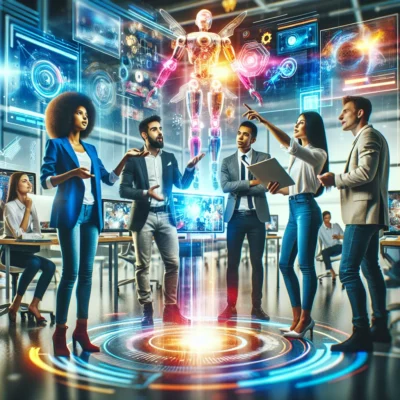Understanding the Importance of Innovation and Learning
Innovation and continuous learning are the bedrock of the tech industry. The rapid pace of technological advancements necessitates a culture where employees are encouraged to think creatively and stay updated with the latest trends and skills.
Why Innovation and Continuous Learning Matter
- Staying Competitive: In an industry where change is the only constant, companies that prioritize innovation and continuous learning stay ahead of the curve. They are better equipped to adapt to market changes and customer needs.
- Driving Growth: Innovative solutions lead to new products, services, and business models, driving growth and opening new revenue streams.
- Employee Satisfaction: A culture that values learning and innovation keeps employees engaged and motivated, reducing turnover rates.
Real-World Examples
- Google: Known for its “20% time” policy, Google encourages employees to spend 20% of their time on projects they are passionate about, leading to innovations like Gmail and Google Maps.
- Amazon: With its focus on customer obsession and a culture of experimentation, Amazon continuously innovates, from AWS to Prime services.
Creating an Environment that Encourages Experimentation
Strategies for Promoting a Safe Space
- Psychological Safety: Ensure that team members feel safe to take risks without fear of punishment. Encourage open communication and respect diverse opinions.
- Leadership Support: Leaders should model the behavior they wish to see by being open to new ideas and not penalizing failure.
- Celebrate Small Wins: Recognize and celebrate even the smallest successes to build momentum and encourage further experimentation.
Learning from Failures
- Post-Mortem Analysis: Conduct regular reviews of failed projects to understand what went wrong and how to improve.
- Transparent Communication: Share lessons learned from failures across the team to prevent repeat mistakes and foster a culture of continuous improvement.
Implementing Continuous Learning Programs
Benefits of Continuous Education
- Skill Enhancement: Regular upskilling ensures that team members are proficient in the latest technologies and methodologies.
- Career Growth: Continuous learning opens up new career opportunities for employees, making them more valuable to the organization.
Learning Formats
- Workshops and Seminars: Interactive sessions that provide hands-on experience.
- Online Courses: Flexible learning options that employees can complete at their own pace.
- Hackathons: Encourage creative problem-solving and collaboration.
Importance of Certifications
Certifications validate skills and knowledge, making employees more credible and boosting their confidence. They also signal to the industry that your team is committed to maintaining high standards.
Leveraging Technology to Facilitate Learning and Innovation
Collaborative Tools
- Slack and Microsoft Teams: Facilitate real-time communication and collaboration.
- Confluence and Notion: Platforms for documenting and sharing knowledge.
AI and Machine Learning
- Personalized Learning: AI-driven platforms can tailor learning experiences to individual needs, making training more effective.
- Progress Tracking: Tools like Coursera and Udemy offer features to monitor learning progress and identify areas for improvement.
Tech Tools for Innovation
- JIRA and Trello: Project management tools that help track progress and manage tasks efficiently.
- GitHub: A platform for collaborative coding and version control.
Encouraging Cross-Functional Collaboration
Importance of Diverse Perspectives
- Innovative Solutions: Diverse teams bring varied perspectives, leading to more creative and effective solutions.
- Holistic Problem-Solving: Cross-functional collaboration ensures that all aspects of a problem are considered, leading to more comprehensive solutions.
Fostering Collaboration
- Inter-Departmental Meetings: Regular meetings between different departments to discuss ongoing projects and potential collaborations.
- Shared Goals: Aligning team objectives to ensure everyone is working towards a common goal.
Success Stories
- Spotify: Known for its “Squad” model, Spotify encourages cross-functional teams to work on different aspects of the product, leading to rapid innovation and continuous improvement.
Building a Feedback-Driven Culture
Importance of Regular Feedback
- Continuous Improvement: Regular feedback helps identify areas for improvement and fosters a culture of continuous learning.
- Employee Development: Constructive feedback guides employees in their career growth and skill development.
Tips for Constructive Feedback
- Be Specific: Provide clear, actionable feedback rather than vague comments.
- Timely Feedback: Offer feedback close to the event to ensure relevance and impact.
- Balanced Approach: Combine positive feedback with areas for improvement to maintain motivation.
Role of Feedback in Innovation
Feedback loops help teams iterate quickly, refining ideas and solutions based on real-world input, leading to more innovative outcomes.
Recognizing and Rewarding Innovation and Learning
Impact on Employee Motivation
- Boosts Morale: Recognition and rewards make employees feel valued and appreciated, boosting morale.
- Encourages Innovation: Acknowledging innovative ideas motivates employees to continue pushing boundaries.
Ways to Acknowledge Innovation
- Awards and Bonuses: Monetary rewards for exceptional contributions.
- Public Recognition: Highlighting achievements in company meetings or newsletters.
- Professional Development Opportunities: Offering training or conference attendance as a reward.
Effective Recognition Programs
- 3M: Known for its “15% rule,” 3M encourages employees to spend 15% of their time on projects of their choice, rewarding successful innovations with various incentives.
Cultivating a Growth Mindset
What is a Growth Mindset?
A growth mindset is the belief that abilities and intelligence can be developed through dedication and hard work. This mindset fosters a love for learning and resilience, essential for innovation.
Encouraging a Growth Mindset
- Promote Learning: Encourage team members to take on new challenges and view failures as learning opportunities.
- Provide Resources: Offer access to learning materials and courses to support skill development.
- Lead by Example: Leaders should demonstrate a growth mindset by continuously seeking new knowledge and skills.
Success Stories
- Microsoft: Under Satya Nadella’s leadership, Microsoft embraced a growth mindset, leading to a cultural transformation and significant business success.
The Road Ahead
Fostering a culture of innovation and continuous learning is not a one-time effort but an ongoing journey. By implementing these strategies, businesses can create tech teams that are not only highly skilled but also motivated to push the boundaries of what’s possible. The future belongs to those who are willing to learn, adapt, and innovate continuously.



